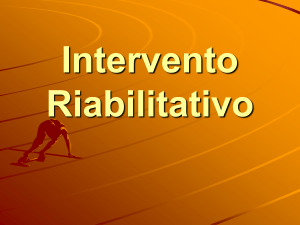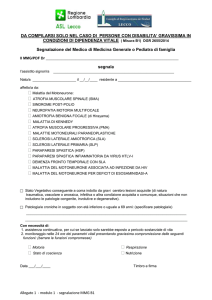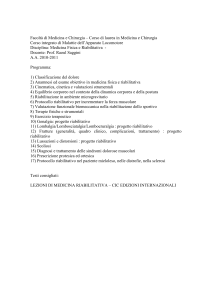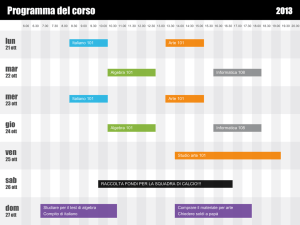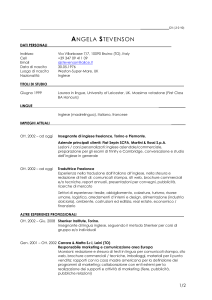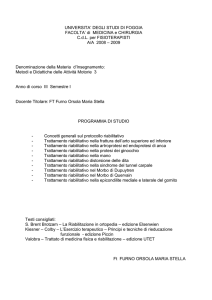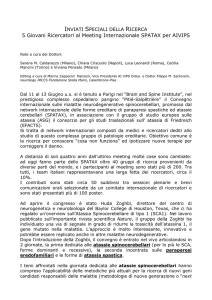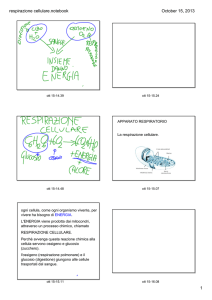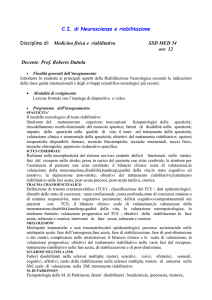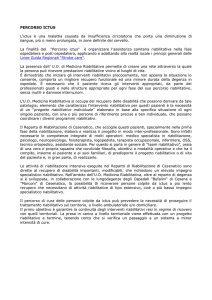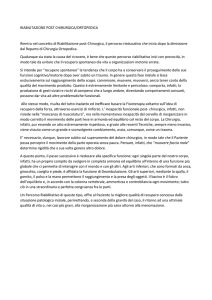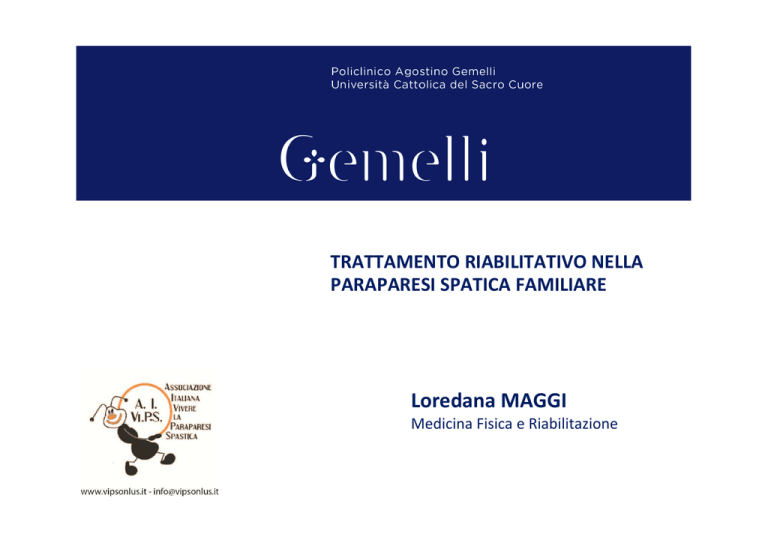
TRATTAMENTO RIABILITATIVO NELLA
PARAPARESI SPATICA FAMILIARE
Loredana MAGGI
Medicina Fisica e Riabilitazione
PARAPARESI SPATICA FAMILIARE
disturbi del movimento clinicamente e
geneticamente eterogenei
Trattamento Riabilitativo nelle Paraparesi Spastiche
L. Maggi - 03 ott. 2015
PARAPARESI SPATICA FAMILIARE
degenerazione assonale
retrograda distale del
fascio corticospinale
Trattamento Riabilitativo nelle Paraparesi Spastiche
L. Maggi - 03 ott. 2015
SINDROME DEL MOTONEURONE SUPERIORE (UMNS)
Fenomeni “negativi”
• Ipostenia
• affaticabilità
• Riduzione del reclutamento delle
Unità Motorie
Trattamento Riabilitativo nelle Paraparesi Spastiche
“Fenomeni positivi”
• Ipertonia
• > riflessi stiramento fasici
• Clono
• Spasmi flessoestensori
• Alterazione riflessi cutanei
• Babinski
• Co-contrazioni/distonia
L. Maggi - 03 ott. 2015
PARAPARESI SPATICA FAMILIARE
caratterizzata da debolezza
prevalentemente agli arti inferiori
e
spasticità
localizzate
Muscle paresis and passive stiffness: key determinants in limiting function in Hereditary and
Sporadic Spastic Paraparesis. Marsden J, Ramdharry G, Stevenson V, Thompson A. Gait
Posture. 2012
Trattamento Riabilitativo nelle Paraparesi Spastiche
L. Maggi - 03 ott. 2015
PARAPARESI SPATICA FAMILIARE
•L’ipertonia
e l’ipostenia muscolare si presentano con
progressività ed intensità variabile nei vari soggetti .
• Alcuni soggetti hanno spasticità e non deficit di forza,
mentre altri presentano con la stessa intensità i 2 sintomi.
Trattamento Riabilitativo nelle Paraparesi Spastiche
L. Maggi - 03 ott. 2015
PARAPARESI SPATICA FAMILIARE
Si classificano in:
• forme non complicate con coinvolgimento degli arti
inferiori, iper-reflessia , riflesso plantare in estensione,
ipertono vescicale e lieve riduzione della sensibilità
vibratoria
• forme complicate in cui si possono aggiungere altri
disturbi neurologici come atassia, deterioramento
cognitivo, disturbi extrapiramidali, neuropatie periferiche.
Le forme cliniche più frequenti sono le non complicate
Trattamento Riabilitativo nelle Paraparesi Spastiche
L. Maggi - 03 ott. 2015
PARAPARESI SPATICA FAMILIARE
•
Fase iniziale
– marcia sulle punte,
– contrattura progressiva arti
inferiori (difficoltà di marcia
veloce, corsa, ostacoli del
terreno)
– crampi ai piedi polpacci coscia
– Spasticità > dalle emozioni,
stress, contrarietà,
raffreddamento
Trattamento Riabilitativo nelle Paraparesi Spastiche
L. Maggi - 03 ott. 2015
PARAPARESI SPATICA FAMILIARE
•
•
Fase di stato
– parapararesi spastica con
marcia a forbice, piede falciante
– Tono muscolare spesso
normale a riposo,ma spastico
durante la marcia o messa in
tensione;
– Deficit di forza moderato; arti
superiori poco o per nulla
colpiti
– Affaticabilità durante e dopo
sforzo
Fase avanzata
– Paraplegia spastica
– Fatica anche a riposo
Trattamento Riabilitativo nelle Paraparesi Spastiche
L. Maggi - 03 ott. 2015
PARAPARESI SPATICA FAMILIARE
Ad oggi esistono solo terapie sintomatiche mirate a
ridurre i sintomi e migliorare l’equilibrio,
la forza
muscolare e l’agilità mediante attività quotidiane di
terapia fisica.
Autonomia
QoL
Trattamento Riabilitativo nelle Paraparesi Spastiche
L. Maggi - 03 ott. 2015
PARAPARESI SPATICA FAMILIARE
La strategia terapeutica prevede la presa in carico globale del
paziente mediante un progetto riabilitativo che integra diverse
trattamenti:
1.Riduzione della spasticità
2.Miglioramento della forza muscolare
3.Trattamenti ortesici
4.Prescrizione di ausili tecnici per migliorare lo svolgimento
delle attività quotidiane e della marcia
5.Attività aerobiche per mantenere- migliorare la capacità
cardio-respiratoria
Trattamento Riabilitativo nelle Paraparesi Spastiche
L. Maggi - 03 ott. 2015
SPASTICITÀ
Aumento velocità dipendente del tono muscolare (riflesso
tonico da stiramento), associato ad iperreflessia osteotendinea (riflesso fasico da stiramento), interessante
preferenzialmente alcuni gruppi muscolari e dovuto ad
un’anomala elaborazione degli input sensitivi primari quale
espressione di una sofferenza del I motoneurone
(Young, 1994)
Trattamento Riabilitativo nelle Paraparesi Spastiche
L. Maggi - 03 ott. 2015
SPASTICITÀ
•
Lo sviluppo della spasticità sarà determinato non solo dall’estensione e dalla
gravità del danno sopraspinale ma anche da influenze ambientali quali
postura, sforzo…
•
I cambiamenti di lunghezza imposti dalla postura spastica possono portare a
alterazioni delle proprietà reologiche visco-elastiche del muscolo
•
Trasformazioni di unità motorie dal tipo II al tipo I
Trattamento Riabilitativo nelle Paraparesi Spastiche
L. Maggi - 03 ott. 2015
SPASTICITÀ
• Ostacola il movimento che viene
prodotto con maggiore sforzo
• Porta a retrazioni muscolari e
accorciamenti tendinei→ deformazioni
delle articolazioni
• Interferisce negativamente con le
capacità funzionali motorie del paziente
Trattamento Riabilitativo nelle Paraparesi Spastiche
L. Maggi - 03 ott. 2015
PARAPARESI SPATICA FAMILIARE
La spasticità in genere è intensa nei muscoli:
ischio- crurali
quadricipite
adduttori
gastrocnemio –soleo
il deficit di forza interessa maggiormente i muscoli:
l’ileopsoas
ischio-crurali
tibiale anteriore
Trattamento Riabilitativo nelle Paraparesi Spastiche
VALUTAZIONE
FUNZIONALE
L. Maggi - 03 ott. 2015
PARAPARESI SPATICA FAMILIARE
1. Farmaci miorilassanti o infiltrazioni focali di tossina
botulinica vengono utilizzati per ridurre l’ipertono
muscolare
2. L'uso della tossina botulinica nella paraparesi spastica è
ormai procedura consolidata e fornisce ottimi risultati
3. Va accompagnata, subito dopo la somministrazione, al
trattamento riabilitativo
Trattamento Riabilitativo nelle Paraparesi Spastiche
L. Maggi - 03 ott. 2015
Quale fisioterapia è più adatta?
Quale esercizio è più adatto?
Non esistono evidenze scientifiche su l’efficacia
di una tecnica riabilitativa rispetto all’altra.
Trattamento Riabilitativo nelle Paraparesi Spastiche
L. Maggi - 03 ott. 2015
TRATTAMENTO RIABILITATIVO
•
•
•
•
•
•
•
Allungamenti muscolari con manovre dolci e lente
Mobilizzazioni articolari
Rinforzo muscolare
Esercizi autogestiti
Idroterapia
Tecniche basate su presa di coscienza Feldenkrais
Yoga
Trattamento Riabilitativo nelle Paraparesi Spastiche
L. Maggi - 03 ott. 2015
PARAPARESI SPATICA FAMILIARE
Rieducazione funzionale
•Migliorare la motilità
•Contenere la spasticità
•Prevenire- correggere deformazioni articolari
•Addestrare ai passaggi di postura
•Migliorare la deambulazione (mt, velocità, ostacoli)
•Gestire il dolore
Trattamento Riabilitativo nelle Paraparesi Spastiche
L. Maggi - 03 ott. 2015
TRATTAMENTO RIABILITATIVO
Esercizio terapeutico
•All'inibizione del tono spastico
•Stretching dei muscoli infiltrati
•Rinforzo dei muscoli antagonisti
•Al controllo muscolare segmentario
Trattamento Riabilitativo nelle Paraparesi Spastiche
L. Maggi - 03 ott. 2015
STRETCHING
Attivo
Passivo
Tecniche di contrazione – tenuta- rilasciamento lento
sotto la soglia del riflesso miotatico
Può generare dolore → gestire con terapia fisica
Effetto transitorio → ripetere più volte/die
A breve termine → riduzione della spasticità
A lungo termine → previene retrazioni muscolari
Trattamento Riabilitativo nelle Paraparesi Spastiche
L. Maggi - 03 ott. 2015
STRETCHING
Although calf muscle spasticity is often treated with botulinum toxin type-A, the effects on balance and gait are ambiguous.
Hereditary spastic paraplegia is characterized by progressive spasticity and relatively mild muscle weakness of the lower limbs. It
is therefore a good model to evaluate the functional effects of botulinum toxin type-A.
DESIGN: Explorative pre-post intervention study.
SUBJECTS: Fifteen subjects with pure hereditary spastic paraplegia.
METHODS: Patients with symptomatic calf muscle spasticity and preserved calf muscle strength received botulinum toxin type-A
injections in each triceps surae (Dysport®, 500-750 MU) followed by daily stretching exercises (18 weeks). Before intervention
(T0), and 4 (T1) and 18 (T2) weeks thereafter, gait, balance, motor selectivity, calf muscle tone and strength were tested.
RESULTS: Mean comfortable gait velocity increased from T0 (0.90 m/s (standard deviation (SD) 0.18)) to T1 (0.98 m/s (SD 0.20)),
which effect persisted at T2, whereas balance and other functional measures remained unchanged. Calf muscle tone declined
from T0 (median 2; range 1-2) to T1 (median 0; range 0-1), which effect partially persisted at T2 (median 1; range 0-2). Calf
muscle strength did not change.
CONCLUSION: Botulinum toxin type-A treatment and subsequent muscle stretching of the
calves improved comfortable gait velocity and reduced muscle tone in patients with
hereditary spastic paraplegia, while preserving muscle strength. Balance remained unaffected.
Functional effects of botulinum toxin type-A treatment and subsequent stretching of spastic calf muscles: a
study in patients with hereditary spastic paraplegia.
de Niet M, de Bot ST, van de Warrenburg BP, Weerdesteyn V, Geurts AC. J Rehabil Med. 2015
Trattamento Riabilitativo nelle Paraparesi Spastiche
L. Maggi - 03 ott. 2015
RINFORZO MUSCOLARE
•
•
Esercizi con reclutamento isometrico e isotonico >eccentrico
Esercizi propriocettivi
Trattamento Riabilitativo nelle Paraparesi Spastiche
L. Maggi - 03 ott. 2015
DISTURBI DI EQUILIBRIO
OBJECTIVE: To determine how postural sway is affected in people with spastic paraparesis (pwSP)
and the impact of different impairments.
METHODS: In 20 pwSP and 18 matched healthy controls standing postural sway was measured with
eyes open and closed. Vibration threshold, isometric ankle and hip muscle strength and ankle
stiffness with the participant at rest or preactivating the muscle was measured.
RESULTS: Antero-posterior (AP) and medio-lateral (ML) sway was higher in pwSP. Muscle strength
was reduced and ankle stiffness increased in pwSP. Increased vibratory threshold was seen in 35% of
participants. Higher total ankle stiffness (R2=0.44) was associated with lower AP sway with eyes open
whilst hip abductor weakness was associated with increased ML sway with eyes open (R2=0.36) or
closed (R2=0.47) or AP sway with the eyes closed (R2=0.48).
CONCLUSIONS: The degree of postural sway was related to muscle paresis of the hip abductors
particularly in the ML direction and under conditions of reduced sensory input. People with higher
total ankle stiffness have less AP sway suggesting that this may help to stabilise the body.
Balance dysfunction in hereditary and spontaneous spastic paraparesis. Marsden J, Stevenson V.
Gait Posture. 2013
Trattamento Riabilitativo nelle Paraparesi Spastiche
L. Maggi - 03 ott. 2015
IDROTERAPIA
BACKGROUND:Hereditary spastic paraparesis (HSP) is a group of neurological disorders characterised by slowly progressive increasing
muscle tone, predominantly in the lower limbs, with relatively preserved power. This leads to progressive difficulties in motor control
and walking.
OBJECTIVE:The purpose of this study was to evaluate the effectiveness of hydrotherapy treatment when used as a means to increase
locomotor function in individuals with late onset HSP. This paper discusses the analysis of the effect on gait characteristics.
METHODS:Nine people with HSP were asked to participate in pre- and post-hydrotherapy gait analyses. Ground reaction force and
motion trajectories were recorded and used to calculate spatiotemporal gait parameters, joint angles and moments.
RESULTS:The normalised joint kinematics and kinetics profile revealed that the biomechanics of people with HSP were similar to that of
controls for most of the joints, but with lower range of motion. Walking speed increased significantly (11%) after the course
of hydrotherapy. Though part of this was achieved through increased ROM there was also a further increase in hip internal rotation and
in peak hip extension moment.
CONCLUSIONS:Although participants had increased walking speed and step length, it appears
that hydrotherapy increases the ability to perform compensatory strategies rather than resulting in a
more typical kinematic and kinetic approach
The effect of hydrotherapy treatment on gait characteristics of hereditary spastic paraparesis patients.
Zhang Y, Roxburgh R, Huang L, Parsons J, Davies TC. Gait Posture. 2014
Trattamento Riabilitativo nelle Paraparesi Spastiche
L. Maggi - 03 ott. 2015
TERAPIE FISICHE STRUMENTALI
Functional Electrical Stimulation FES
FES increases dorsiflexor torque, improves toe clearance and dorsiflexion in swing
phase, and significantly improves walking speed
The effects of functional electrical stimulation on walking in hereditary and spontaneous spastic paraparesis.
Marsden J, Stevenson V, McFadden C, Swain I, Taylor P. Neuromodulation. 2013
Trattamento Riabilitativo nelle Paraparesi Spastiche
L. Maggi - 03 ott. 2015
VIBRAZIONE MECCANICA FOCALE
….In conclusion, focal vibration stimulation is well tolerated, effective and easy to
use, and it could be used to reduce spasticity, to promote motor activity and motor
learning within a functional activity, even in gait training, independent from etiology
of neurological pathology.
Focal vibration in neurorehabilitation.
Murillo N, Valls-Sole J, Vidal J, Opisso E, Medina J, Kumru H. Eur J Phys Rehabil Med. 2014
Trattamento Riabilitativo nelle Paraparesi Spastiche
L. Maggi - 03 ott. 2015
DOLORI ….
Trattamento Riabilitativo nelle Paraparesi Spastiche
L. Maggi - 03 ott. 2015
ORTESI
Dispositivi che mantengono –migliorano
il corretto allineamento articolare
Trattamento Riabilitativo nelle Paraparesi Spastiche
L. Maggi - 03 ott. 2015
ORTESI GAMBA PIEDE
Trattamento Riabilitativo nelle Paraparesi Spastiche
L. Maggi - 03 ott. 2015
AUSILI PER LA DEAMBULAZIONE
bastoni canandesi, deambulatori
•
Funzioni:
•
•
allargare la base di appoggio
compensare deficit muscolari o
articolari
trasferire agli arti superiori parte
del carico in modo da alleggerire
l’arto debole o dolorante
esercitare una spinta propulsiva
facilitare il raddrizzamento e
l’allineamento dei segmenti
corporei
•
•
Trattamento Riabilitativo nelle Paraparesi Spastiche
L. Maggi - 03 ott. 2015
AUSILI PER LA DEAMBULAZIONE
Trattamento Riabilitativo nelle Paraparesi Spastiche
L. Maggi - 03 ott. 2015
AUSILI PER LA CASA
Trattamento Riabilitativo nelle Paraparesi Spastiche
L. Maggi - 03 ott. 2015
ESERCIZIO AEROBICO
Poco ma spesso
senza raggiungere la soglia della fatica
Trattamento Riabilitativo nelle Paraparesi Spastiche
L. Maggi - 03 ott. 2015
PEDALIERA
Previene atrofia muscolare
Migliora la circolazione sanguigna
Trattamento Riabilitativo nelle Paraparesi Spastiche
L. Maggi - 03 ott. 2015
GRAZIE
DELL ’ATTENZIONE

